
Uncover the Silent Signals: Unveiling Warning Signs of Dental Issues in Your Canine Companion
$59.00
Discover the telltale signs that indicate your furry companion may be suffering from dental issues. From bad breath and bleeding gums to difficulty chewing, this guide empowers you to identify and address your dog’s dental problems promptly, ensuring a healthy and pain-free life.
Description
Warning Signs of Dental Problems in Dogs: A Comprehensive Guide
Dental problems are a common health issue in dogs, affecting up to 80% of pets by the age of three. Despite their prevalence, many owners may not recognize the early signs of dental disease, leading to pain, discomfort, and potentially serious health consequences for their furry companions. This comprehensive guide will shed light on the crucial warning signs of dental issues in dogs, empowering you to identify and seek treatment promptly.
H2: Symptoms of Dental Problems in Dogs
1. Bad Breath (Halitosis): A foul odor emanating from your dog’s mouth is one of the most common signs of dental problems. Plaque and tartar buildup, gingivitis, and periodontal disease can all contribute to halitosis.
2. Loose or Broken Teeth: Dental disease can weaken the structure of the teeth, leading to loose or broken ones. Loose teeth can cause pain and discomfort and should be addressed immediately.
3. Excessive Drooling: While some dog breeds are prone to drooling, excessive drooling can be a sign of dental pain or discomfort. If your dog is drooling more than usual, especially when eating or chewing, it warrants a veterinary examination.
4. Difficulty Eating or Chewing: Dental problems can make eating and chewing painful or difficult. You may notice your dog dropping food, chewing on one side of their mouth, or refusing to eat altogether.
5. Swelling or Redness of Gums: Inflamed or swollen gums are a classic symptom of gingivitis, the early stage of periodontal disease. Look for redness, swelling, or bleeding along the gum line.
6. Bleeding from the Mouth: Any bleeding from your dog’s mouth, whether it’s when chewing, brushing their teeth, or otherwise, is a potential sign of dental problems and should be investigated.
7. Nasal Discharge: In advanced cases of periodontal disease, bacteria can spread to the sinuses, causing nasal discharge. If your dog has a persistent nasal discharge, it’s important to rule out dental disease as a potential cause.
H3: Causes of Dental Problems in Dogs
1. Poor Dental Hygiene: Regular brushing and dental checkups are essential for maintaining good oral health in dogs. Neglecting these measures allows plaque and tartar to accumulate, leading to dental problems.
2. Certain Breeds: Some dog breeds, such as small breeds, brachycephalic breeds (e.g., pugs, bulldogs), and toy breeds, are more prone to dental issues due to their smaller teeth and narrow mouths.
3. Dental Trauma: Accidents, chewing on hard objects, or fights can cause dental trauma, such as chipped or broken teeth. This can lead to exposed nerves and severe pain.
4. Underlying Health Conditions: Certain health conditions, such as diabetes and kidney disease, can compromise the immune system and make dogs more susceptible to dental problems.
H2: Treatment and Prevention of Dental Problems in Dogs
1. Veterinary Examination and Diagnosis: A dental examination is crucial for accurate diagnosis and treatment planning. Your veterinarian will visually inspect your dog’s mouth, check for any signs of disease, and may recommend X-rays to assess the extent of dental damage.
2. Dental Cleaning: Regular dental cleanings remove plaque and tartar buildup, reducing the risk of dental disease. Depending on the severity of the problem, your veterinarian may use ultrasonic scaling, polishing, and fluoride treatment to restore dental health.
3. Antibiotics and Medications: In cases of infection or severe dental disease, antibiotics or other medications may be prescribed to control infection and pain.
4. Tooth Extractions: If dental disease has damaged teeth beyond repair, tooth extractions may be necessary to eliminate pain and prevent further infection.
5. Home Dental Care: Brushing your dog’s teeth regularly, providing dental chews, and offering a dental diet can help maintain good oral hygiene and prevent future dental problems.
H2: Importance of Regular Dental Checkups
Regular dental checkups are vital for detecting dental problems early on, when they are more easily treated. During these checkups, your veterinarian will:
1. Examine Your Dog’s Mouth: They will check for any signs of plaque, tartar, gingivitis, or other dental abnormalities.
2. Perform Dental Cleaning: If necessary, they will perform a dental cleaning to remove plaque and tartar buildup and assess the health of your dog’s teeth and gums.
3. Provide Dental Advice: Your veterinarian can provide individualized advice on how to maintain your dog’s dental health, including brushing techniques, dental products, and diet recommendations.
By following these guidelines and staying vigilant for the warning signs of dental problems, you can ensure your furry companion enjoys a healthy and pain-free life with a beautiful smile. Remember, your dog’s dental health is an investment in their overall well-being and happiness.



